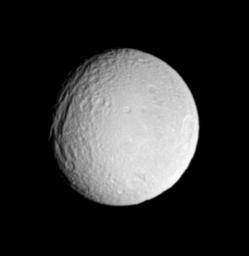
|
Icy Scars
- Click the image above for a larger view
- Full-Res JPEG (534 x 550) (13.8 kB)
- Full-Res TIFF (534 x 550) (294.2 kB)
Caption:
Saturn's icy moon Tethys displays a very old impact basin here, just southeast of its giant canyon system, Ithaca Chasma. The large crater has been degraded, or softened, by time and a more recent impact has formed a smaller crater near its southern edge. This large basin was first seen in images from the NASA Voyager mission. Tethys is 1,071 kilometers (665 miles) across.
A sharper, presumably younger crater called Penelope lies near the eastern limb, at the 3 o'clock position. This view shows principally the trailing hemisphere on Tethys. North is directly up.
The image was taken in visible light with the Cassini spacecraft narrow-angle camera on May 20, 2005, at a distance of approximately 1 million kilometers (600,000 miles) from Tethys and at a Sun-Tethys-spacecraft, or phase, angle of 31 degrees. Resolution in the original image was 6 kilometers (4 miles) per pixel. The image has been contrast-enhanced and magnified by a factor of two to aid visibility.
Background Info:
The Cassini-Huygens mission is a cooperative project of NASA, the European Space Agency and the Italian Space Agency. The Jet Propulsion Laboratory, a division of the California Institute of Technology in Pasadena, manages the mission for NASA's Science Mission Directorate, Washington, D.C. The Cassini orbiter and its two onboard cameras were designed, developed and assembled at JPL. The imaging team is based at the Space Science Institute, Boulder, Colo.
For more information about the Cassini-Huygens mission visit http://saturn.jpl.nasa.gov . For additional images visit the Cassini imaging team homepage http://ciclops.org .
Cataloging Keywords:
| Name | Value | Additional Values |
|---|---|---|
| Target | Tethys | |
| System | Saturn | |
| Target Type | Satellite | |
| Mission | Cassini-Huygens | Voyager |
| Instrument Host | Cassini Orbiter | |
| Host Type | Orbiter | Flyby Spacecraft |
| Instrument | Imaging Science Subsystem (ISS) | |
| Detector | Narrow Angle Camera | |
| Extra Keywords | Crater, Grayscale, Impact, Visual | |
| Acquisition Date | ||
| Release Date | 2005-07-05 | |
| Date in Caption | 2005-05-20 | |
| Image Credit | NASA/JPL/Space Science Institute | |
| Source | photojournal.jpl.nasa.gov/catalog/PIA07535 | |
| Identifier | PIA07535 | |
